Ensuring the well-being of a cat when its owner is away is a critical concern for any pet owner. The frequency of a cat sitter’s visits can significantly impact the cat’s health, happiness, and overall comfort. This article explores how many visits a cat sitter should make per day, considering various factors such as the cat’s age, health, temperament, and lifestyle.
Understanding Cat Behavior and Needs
Cats and Their Independence
Cats are often perceived as independent animals that can manage themselves for extended periods. While it’s true that cats do not require the same level of attention as dogs, they still need regular care and interaction to thrive. Understanding that cats have specific needs is crucial when determining how often a cat sitter should visit.
Daily Care Requirements
Every cat requires certain daily care elements, including feeding, fresh water, litter box maintenance, and social interaction. Ensuring these needs are met consistently is essential for the cat’s physical and emotional well-being.
Factors Influencing the Frequency of Visits
Age of the Cat
Kittens: Kittens require more frequent visits compared to adult cats. They need more food, social interaction, and monitoring to ensure they are safe and healthy. A cat sitter should ideally visit kittens at least three times a day.
Adult Cats: Healthy adult cats can typically manage with one or two visits per day. These visits should include feeding, litter box cleaning, and some playtime or interaction.
Senior Cats: Older cats may have specific health needs that require more frequent monitoring. They might need medication or special care, which could necessitate two visits per day.
Health Conditions
Cats with medical conditions or those recovering from surgery require more frequent visits. Administering medication, monitoring health, and providing special care mean that a sitter may need to visit up to three times a day.
Temperament and Social Needs
Some cats are more social and thrive on human interaction. These cats may become anxious or stressed if left alone for too long. For such cats, at least two daily visits are recommended to provide companionship and alleviate loneliness.
Dietary Needs
Cats that have specific dietary requirements or are on a special diet may need more frequent feeding. In such cases, a cat sitter should visit as often as required to ensure the cat’s dietary needs are met without overfeeding or underfeeding.
See Also: When Will My Ragdoll Get Fluffy?
Visit Frequency Recommendations
One Visit Per Day
For many adult cats, one visit per day can suffice if the visit includes feeding, refreshing water, cleaning the litter box, and some playtime. This frequency works well for cats that are more independent and do not have special health or dietary needs.
Two Visits Per Day
Two visits per day are recommended for:
- Cats with medical conditions that need regular monitoring or medication.
- Kittens or senior cats that require more attention and care.
- Social cats that benefit from more human interaction.
During these visits, the cat sitter should ensure that the cat is fed, has fresh water, the litter box is clean, and the cat receives adequate playtime and social interaction.
Three Visits Per Day
Three visits per day might be necessary for:
- Very young kittens that need frequent feeding and monitoring.
- Cats with severe medical conditions that require constant supervision.
- Extremely social cats that become stressed when left alone for extended periods.
Additional Considerations for Cat Sitters
Communication with Pet Owners
A cat sitter should maintain open communication with the pet owner to understand the specific needs of the cat. Regular updates through messages or photos can help reassure the owner that their pet is well cared for.
Emergency Situations
Cat sitters should be prepared for emergencies. Knowing the location of the nearest veterinary clinic and having a list of emergency contacts is essential. Additionally, sitters should be aware of any specific instructions provided by the pet owner regarding emergency procedures.
Providing Enrichment
Visits should include not just basic care but also enrichment activities to keep the cat mentally and physically stimulated. This can include playtime with toys, grooming, or simply spending time with the cat.
Handling Special Needs
Cats with special needs, such as those requiring medication or having mobility issues, need careful attention. Cat sitters should be trained to handle these needs appropriately and ensure the cat’s well-being.
Conclusion
Determining the optimal number of daily visits from a cat sitter depends on various factors, including the cat’s age, health, temperament, and dietary needs. While some cats may do well with a single daily visit, others may require two or even three visits to ensure they receive the necessary care and attention. Pet owners should carefully assess their cat’s specific needs and communicate them clearly to the cat sitter to ensure their furry friend is happy and healthy while they are away.
In conclusion, while the general recommendation for adult cats without special needs is one or two visits per day, each cat is unique, and their care plan should be tailored to their individual requirements. By understanding and meeting these needs, a cat sitter can ensure the cat remains content and well-cared-for in the owner’s absence.

























